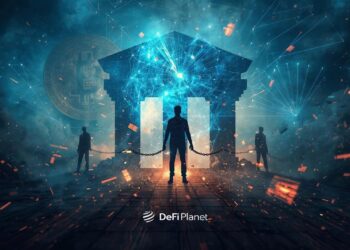As the Total Value Locked (TVL) in DeFi continues to rise, a growing number of on-chain analytical systems are now available to provide valuable data to blockchain investors. While these systems promise to offer insights, it can be challenging to transform raw data into useful information without the right tools.
This is where DeFi dashboards can be extremely helpful.
Investors and analysts often rely on data to create dashboards that display key indicators, with Token Terminal being a popular platform for this purpose.
Token Terminal provides information on the largest blockchains and decentralized applications (dApps), tracking financial parameters for 115 decentralized projects and six blockchain protocols.
This article aims to provide a comprehensive overview of Token Terminal, including what it is, how to use it, and its alternative options.
TL;DR:
- The DeFi space has seen significant growth in Total Value Locked (TVL), leading to more options for DeFi analytics.
- Token Terminal is an excellent choice for those researching blockchain and decentralized applications. It stands out by offering comprehensive DeFi analytics solutions with unique indicators.
- It’s the go-to tool for anyone who wants to quickly access key statistical indicators for different projects, sectors, or categories.
- Using Token Terminal, researchers can easily track and analyze DeFi project performance, make informed decisions, and stay updated on the latest trends and developments in the DeFi space.
What is Token Terminal?
Token Terminal is a platform that aggregates financial information from decentralized applications and blockchains.
Analysts can use the platform to assess the value of protocols and projects based on the financial data collected and processed from their smart contract transactions. Through the Token Terminal API, programmers can access information about past fees from servers such as Uniswap.
Token Terminal allows tracking of protocols with the highest total income, TVL (Total Value Locked), or price-to-sales ratio. This sophisticated platform not only tracks but also compiles historical data for a wide range of metrics.
The tool is accessible to anyone seeking to compare multiple blockchains and decentralized applications. While Token Terminal excels in its capabilities, it falls short in terms of available decentralized applications and protocols. Token Terminal exclusively monitors popular dApps, and, regrettably, it cannot track lesser-known dApps.
At present, Token Terminal monitors 115 decentralized projects and 6 blockchains. This may appear somewhat limited, especially considering the multitude of decentralized applications currently available.
How to Use Token Terminal
To view the market capitalization data for the top 10 decentralized exchanges (DEXs), navigate to the “Exchanges” section under the “Markets” tab. This is just one of the many ways in which Token Terminal provides valuable data.
In addition to market capitalization, you can also find indicators for trading volume and TVL (Total Value Locked) on Token Terminal. Furthermore, Token Terminal offers revenue data, which customers can use to gain a better understanding of each protocol’s growth.
Token Terminal enables users to compare multiple protocols using their preferred indicators through an easy-to-use and interactive graph.
The platform boasts a user-friendly interface and an extensive array of data indicators. It surpasses many other solutions by allowing users to create a dashboard with various charts all on a single page, eliminating the need for constantly switching between indicators.
Pricing
Token Terminal provides a free plan which covers the needs of non-institutional investors and researchers.
For institutional users requiring access to the Token Terminal API, it is available through the PRO plan, priced at €325 (plus VAT) per user per month. While the PRO plan may seem expensive, institutions using the API will find it worthwhile.
However, for most individuals who do not require the advanced features of the PRO plan, the free plan will more than suffice for their needs.
Alternatives to Token Terminal
Other DeFi analytics solutions (apart from Token Terminal) include:
Nansen

Nansen is a well-known DeFi analytics solution preferred by many beginners due to its user-friendly plug-and-play approach. However, it doesn’t support cross-chain functionality, which restricts users from uncovering macro-level insights.
One of Nansen’s distinctive features is its “Token God Mode,” enabling users to select a single token to represent the system’s protocol. Nevertheless, the platform’s analytical logic primarily focuses on providing in-depth analysis of individual tokens, encompassing information about their holders, supply, and exchanges. Consequently, it does not offer a comprehensive view of the entire DEX market.
While Nansen provides access to charts displaying specific tokens, it doesn’t facilitate cross-chain comparisons among various tokens. The “Token Overlap” dashboard permits users to compare only two tokens, with limited comparison variables. Additionally, cross-chain data is currently unavailable for BSC (Binance Smart Chain) or Polygon.
Nansen’s “Dex Trades” dashboard is another valuable feature, offering real-time updates on on-chain transactions between two tagged addresses across various DEXs.
Nansen provides users with real-time data and offers a total of 26 dashboards. However, its primary limitation lies in its inability to compare multiple protocols within a single category.
Dune Analytics

Dune Analytics is a do-it-yourself (DIY) analytics solution platform that offers on-chain data and tools for crafting custom dashboards. The Dune community has created several final dashboards.
To simplify the process of developing a dashboard on a related subject, Dune encourages users to fork queries from any existing dashboard. Users can customize their dashboards by incorporating various queries from other dashboards.
To create new queries, users must use SQL to extract data from the Dune database. A less difficult method is to find a similar query and adjust the query parameters. Users can create a monthly DEX volume query, for example, by forking the existing query (known as Weekly DEX Volume) and changing the time frame from “week” to “month.”
Average users may encounter difficulties when forking and building dashboards with Dune Analytics. This can be a major challenge. Users who lack SQL expertise can only fork identical queries with minor changes. Diving deeper into on-chain data to uncover insights would require technical knowledge.
Chainbeat

Chainbeat specializes in Web3 data insights and analytics. It offers comprehensive cross-blockchain analytics, real-time alerts, and personalized reports based on actual smart contract usage. Additionally, it provides in-depth insights into active users, events, transactions, and token transfers.
Users can create their own dashboards for a specific token in addition to the existing dashboards. They only need to enter the token’s address and wait 30 minutes for the data to be imported.
The Chainbeat dashboard has one overview and three separate reports covering users, transactions, and tokens. The single-token dashboard, on the other hand, may not fully meet the requirements for creating a DEX dashboard, and loading times can be frustratingly long.
Footprint

Footprint is a powerful analytics tool for discovering and presenting blockchain data. The tool is designed with the user in mind, with an intuitive interface for interactive drag-and-drop data queries.
Users can compare cross-chain aspects of the same project or industry to gain insights into the growth of various ecosystems because Footprint emphasizes cross-chain data. Footprint has a similar feature that allows users to replicate dashboards that they are interested in.
Users can also easily share their findings on social media, either as an embedded HTML of a live dashboard or as an image of the entire dashboard. Unlike Nansen and Dune, Footprint updates its data daily rather than in real-time. However, most indicators, such as TVL, are still relevant.
Disclaimer: This article is intended solely for informational purposes only and should not be considered trading or investment advice. Nothing herein should be construed as financial, legal, or tax advice. Trading or investing in cryptocurrencies carries a considerable risk of financial loss. Always conduct due diligence.
If you would like to read more articles like this, visit DeFi Planet and follow us on Twitter, LinkedIn, Facebook, and Instagram, and CoinMarketCap Community.
“Take control of your crypto portfolio with MARKETS PRO, DeFi Planet’s suite of analytics tools.”





















